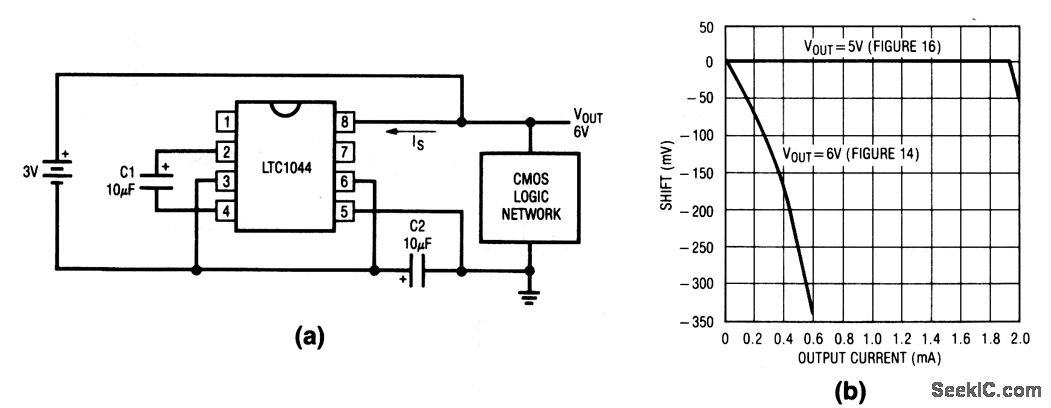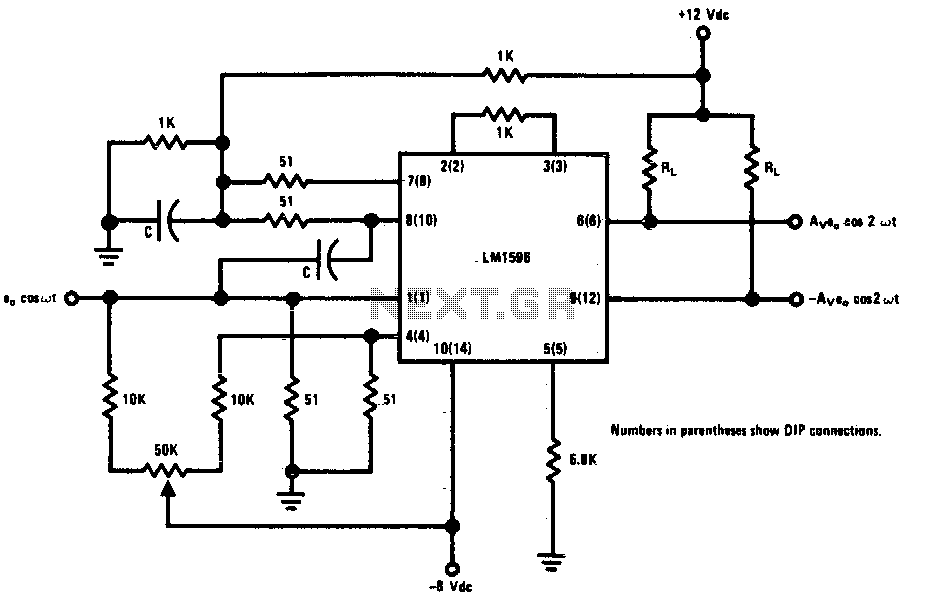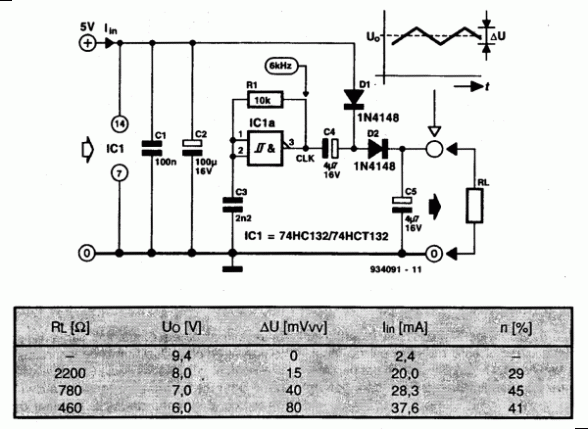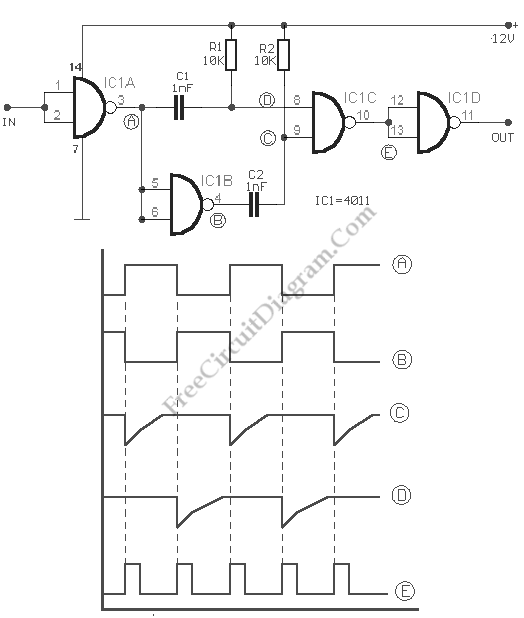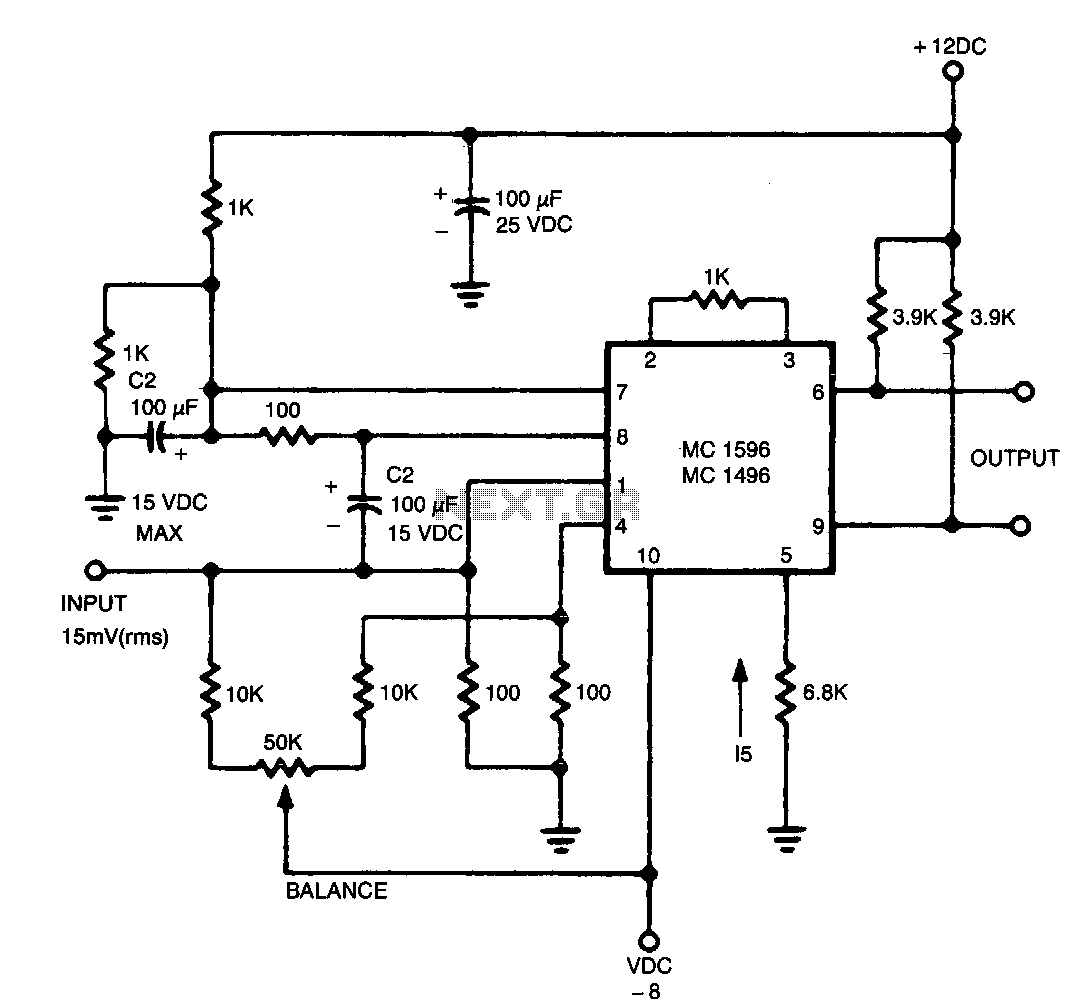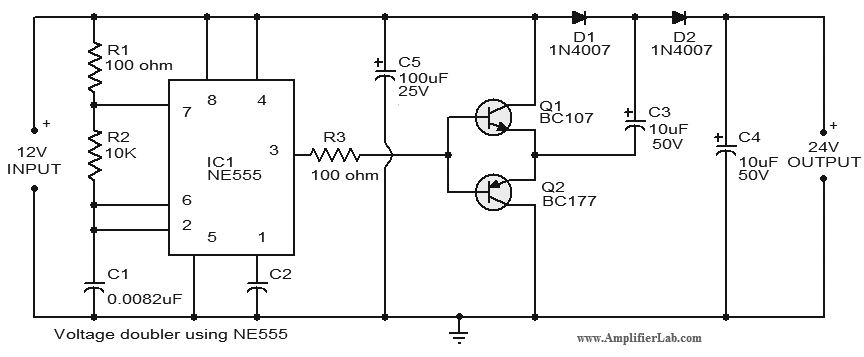
Audio-Frequency Doubler
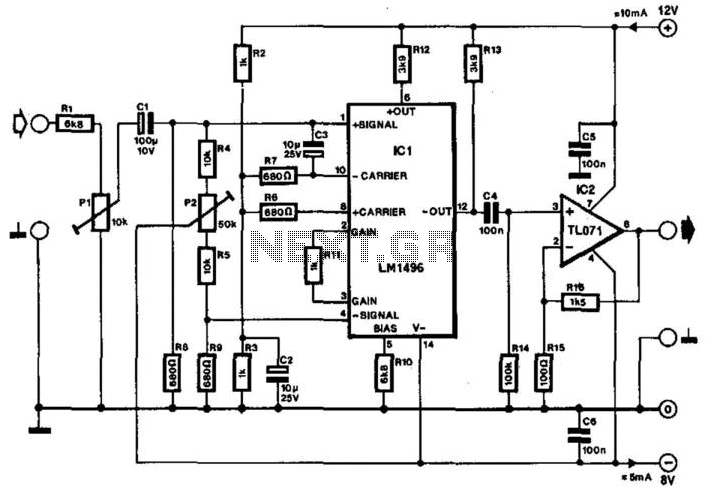
Often, the frequency of a signal must be doubled, and the modulator/demodulator chip LM1496 serves as an ideal basis for this application. From trigonometry, it is well known that 2sin(x)cos(x) = sin(2x) and sin^2(x) = 1 - cos^2(x). These equations indicate that the product of two pure sinusoidal signals of the same frequency results in a signal of double that frequency. The purity of the original signals is crucial, as composite signals can produce various undesired products. The LM1496 can only process signals that do not exceed 25 mV; exceeding this level can lead to significant distortion. Thus, a potential divider is incorporated at the input. This allows, for example, a 500 mV input signal to be reduced to 25 mV at the LM1496's input. To achieve a sufficiently high output signal, the output of IC1 is amplified by op-amp IC2, configured as a non-inverting amplifier. Since the output of IC1 contains a DC component of approximately 8 V, coupling between the two stages is facilitated via capacitor C4. With resistor values R15 and R16 as specified, IC2 provides an amplification of 16 (24 dB). The overall amplification of the circuit is contingent upon the input signal level: with a 1.2 V input, the amplification is unity; when the input decreases to 0.1 V, the amplification drops to 0.1. The input resistor values are set at 680 ohms, balancing high input impedance with low noise levels. To ensure effective suppression of the input signal at the output, the voltages at pin 1 and pin 4 of IC1 must be identical to P4. Using a spectrum analyzer, it is possible to suppress the fundamental (input) frequency by 60 to 70 dB. The output signal at pin 12 is prone to distortion, as the IC is not primarily designed for this operation. The distortion level varies with the input signal: at 1 kHz and an input level of 100 mV, the distortion is about 0.6%; at 500 mV, it increases to 2.3%; and at 1 V, it reaches 6%. The signal-to-noise ratio in these conditions ranges from 60 to 80 dB. The circuit draws 10 mA from the positive supply line and 5 mA from the negative supply line. The phase shift between the input and output signals is approximately 45° (output lags). Although the standard output is taken from pin 12, an output that is 180° shifted relative to that at pin 12 is available at pin 6.
The LM1496 is a versatile integrated circuit designed for frequency modulation and demodulation applications. It is particularly effective in applications where signal integrity and purity are paramount. The circuit's design is predicated on the mathematical relationships between sinusoidal signals, leveraging the chip's ability to double frequencies through the multiplication of two identical frequency signals.
The potential divider at the input serves a dual purpose: it protects the LM1496 from excessive input voltages and ensures that the input signal remains within the operational limits of the chip, thus preserving signal quality. The subsequent amplification stage using an operational amplifier (op-amp) allows for flexibility in output signal levels, making the circuit adaptable to various applications where output strength is critical.
The choice of resistor values for the feedback network of the op-amp is crucial for maintaining the desired gain while minimizing noise. The specified resistor values provide a balance that is essential for maintaining the integrity of the signal throughout the amplification process.
The phase relationship between the input and output signals is a significant consideration in applications involving modulation, as it can affect the overall performance of the system. The ability to suppress the fundamental frequency using a spectrum analyzer illustrates the circuit’s capability to handle complex signal scenarios, making it suitable for advanced communication systems.
The distortion characteristics of the output signal are important for evaluating the circuit's performance in real-world applications. The noted distortion levels at varying input signal strengths indicate the operational limits of the LM1496 and highlight the need for careful signal management in high-frequency applications.
In summary, the LM1496-based circuit provides a robust solution for frequency doubling while maintaining signal integrity. Its design considerations, including input protection, amplification, and distortion management, make it a valuable component in electronic signal processing applications. Often the frequency of a signal must be doubled: modulator/demodulator chip LM1496 is an ideal basis for this. From trigonometry it is well known that: 2simrcosx=sin2* and: sin2 = l-*cos2*. These equations indicate that the product of two pure sinusoidal signals of the same frequency is one signal of double that frequency. The purity of the original signals is important: composite signals would give rise to all sorts of undesired products.
The LM1496 can only process signals that are not greater than 25 mV: above that level, serious distortion will occur. The design is therefore provided with a potential divider at its input. This addition makes it possible, for instance, to arrange for a 500-mV input signal to result in a signal of only 25 mV at the input of the LM1496.
To provide a sufficiently high output signal, the output of IC1 is magnified by op amp IC2, which is connected as a noninverting amplifier. Because the output of IC1 contains a dc component of about 8 V, the coupling between the two stages must be via a capacitor, C4.
With values of R15 and R16 as shown, IC2 gives an amplification of 16 (24 dB). The overall amplification of the circuit depends on the level of the input signal: with an input of 1.2 V, the amplification is unity; when the input drops to 0.1 V, the amplification is just 0.1. The value of the input resistors has been fixed at 680 : this value gives a reasonable compromise between the requirements for a high input impedance and a low noise level.
lb ensure good suppression of the input signal at the output, the voltages at pin 1 and pin 4 of ICl must be absolutely identical to P4, It is possible, With the aid of a spectrum analyzer, to suppress the fundamental (input) frequency by 60 to 70 dB. The output signal at pin 12 is distorted easily, because the IC is not really designed for this kind of operation.
The distortion depends on the level of the input signal. At a frequency of 1 kHz and an input level of 100 mV, the distortion is about 0.6%; when the input level is raised to 500 mV, the distortion increases to 2.3%, and when the input level is 1 V, the distortion is 6%. The signal-to-noise ratio under these conditions varies between 60 and 80 dB. The circuit draws a current of 10 mA from the positive supply line and 5 mA from the negative line. The phase shift between the input and output signals is about 45° (output lags). Finally, although the normal output is taken from pin 12, a similar output that is shifted by 180° (with respect to that at pin 12), is available at pin 6.
🔗 External reference
The LM1496 is a versatile integrated circuit designed for frequency modulation and demodulation applications. It is particularly effective in applications where signal integrity and purity are paramount. The circuit's design is predicated on the mathematical relationships between sinusoidal signals, leveraging the chip's ability to double frequencies through the multiplication of two identical frequency signals.
The potential divider at the input serves a dual purpose: it protects the LM1496 from excessive input voltages and ensures that the input signal remains within the operational limits of the chip, thus preserving signal quality. The subsequent amplification stage using an operational amplifier (op-amp) allows for flexibility in output signal levels, making the circuit adaptable to various applications where output strength is critical.
The choice of resistor values for the feedback network of the op-amp is crucial for maintaining the desired gain while minimizing noise. The specified resistor values provide a balance that is essential for maintaining the integrity of the signal throughout the amplification process.
The phase relationship between the input and output signals is a significant consideration in applications involving modulation, as it can affect the overall performance of the system. The ability to suppress the fundamental frequency using a spectrum analyzer illustrates the circuit’s capability to handle complex signal scenarios, making it suitable for advanced communication systems.
The distortion characteristics of the output signal are important for evaluating the circuit's performance in real-world applications. The noted distortion levels at varying input signal strengths indicate the operational limits of the LM1496 and highlight the need for careful signal management in high-frequency applications.
In summary, the LM1496-based circuit provides a robust solution for frequency doubling while maintaining signal integrity. Its design considerations, including input protection, amplification, and distortion management, make it a valuable component in electronic signal processing applications. Often the frequency of a signal must be doubled: modulator/demodulator chip LM1496 is an ideal basis for this. From trigonometry it is well known that: 2simrcosx=sin2* and: sin2 = l-*cos2*. These equations indicate that the product of two pure sinusoidal signals of the same frequency is one signal of double that frequency. The purity of the original signals is important: composite signals would give rise to all sorts of undesired products.
The LM1496 can only process signals that are not greater than 25 mV: above that level, serious distortion will occur. The design is therefore provided with a potential divider at its input. This addition makes it possible, for instance, to arrange for a 500-mV input signal to result in a signal of only 25 mV at the input of the LM1496.
To provide a sufficiently high output signal, the output of IC1 is magnified by op amp IC2, which is connected as a noninverting amplifier. Because the output of IC1 contains a dc component of about 8 V, the coupling between the two stages must be via a capacitor, C4.
With values of R15 and R16 as shown, IC2 gives an amplification of 16 (24 dB). The overall amplification of the circuit depends on the level of the input signal: with an input of 1.2 V, the amplification is unity; when the input drops to 0.1 V, the amplification is just 0.1. The value of the input resistors has been fixed at 680 : this value gives a reasonable compromise between the requirements for a high input impedance and a low noise level.
lb ensure good suppression of the input signal at the output, the voltages at pin 1 and pin 4 of ICl must be absolutely identical to P4, It is possible, With the aid of a spectrum analyzer, to suppress the fundamental (input) frequency by 60 to 70 dB. The output signal at pin 12 is distorted easily, because the IC is not really designed for this kind of operation.
The distortion depends on the level of the input signal. At a frequency of 1 kHz and an input level of 100 mV, the distortion is about 0.6%; when the input level is raised to 500 mV, the distortion increases to 2.3%, and when the input level is 1 V, the distortion is 6%. The signal-to-noise ratio under these conditions varies between 60 and 80 dB. The circuit draws a current of 10 mA from the positive supply line and 5 mA from the negative line. The phase shift between the input and output signals is about 45° (output lags). Finally, although the normal output is taken from pin 12, a similar output that is shifted by 180° (with respect to that at pin 12), is available at pin 6.
🔗 External reference
